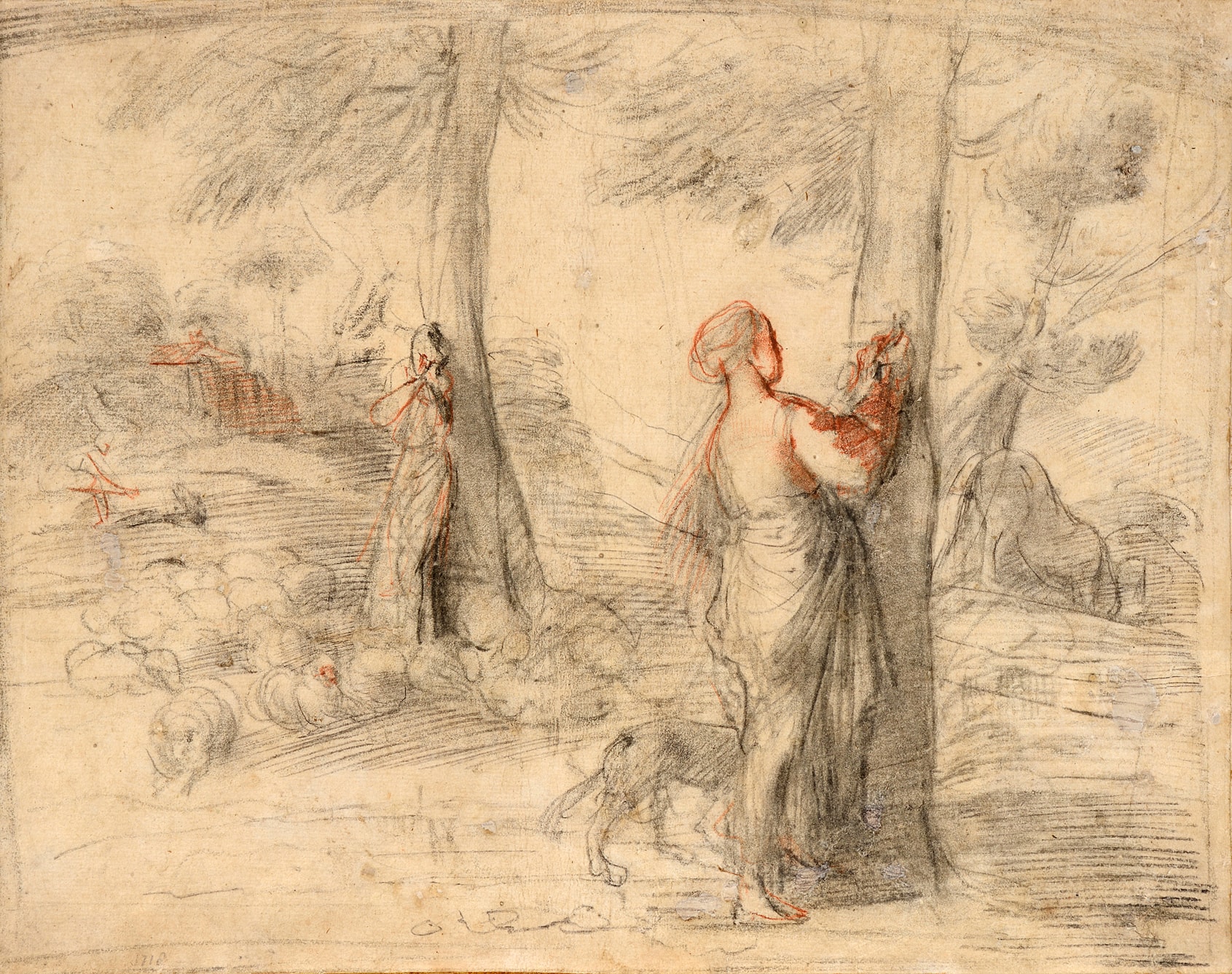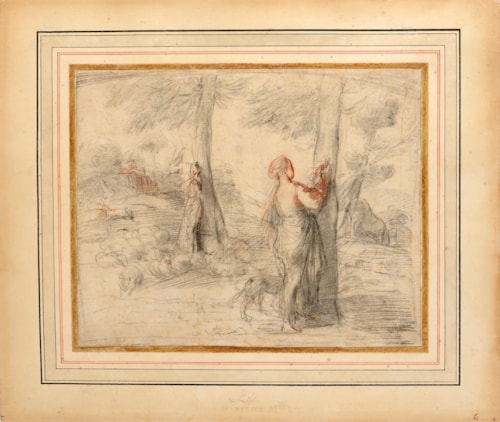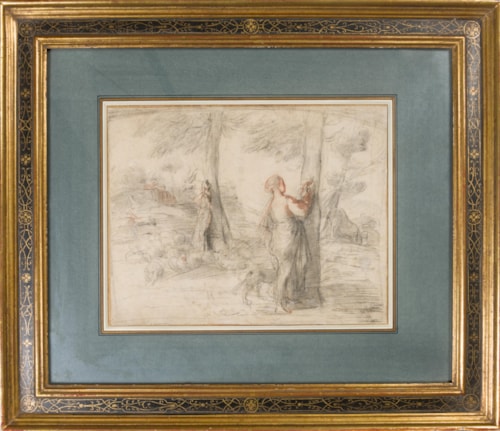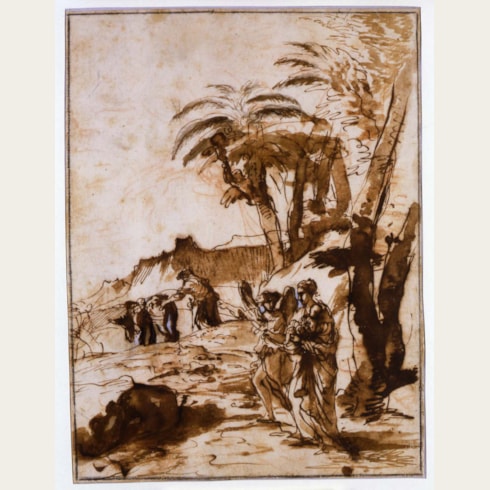Pier Francesco MOLA
(Coldrerio 1612 - Rome 1666)
Landscape with Erminia Writing the Name of Tancred on a Tree
Black and red chalk, with framing lines in balck chalk, on buff paper, laid down.
Numbered 1718 at the lower left.
Inscribed Mola. and PIETRO FRANCESCO MOLA / [?] on the old mount.
Numbered 64 – 4 on the old mount.
Further inscribed A Sketch for a Picture on cloth, in the French King’s Collection. / 2 ft. 1 1/4 Inch. high, by 2 ft. 3 1/4 Inch. wide. Vide Catalogue raisonné / des Tableaux du Roy, par M. Lépicié. Tom. II p.314-5. on the reverse of the old mount.
Also inscribed Francesco Mola and Dijonval Colln on the reverse of the old mount.
254 x 323 mm. (10 x 12 3/4 in.)
Numbered 1718 at the lower left.
Inscribed Mola. and PIETRO FRANCESCO MOLA / [?] on the old mount.
Numbered 64 – 4 on the old mount.
Further inscribed A Sketch for a Picture on cloth, in the French King’s Collection. / 2 ft. 1 1/4 Inch. high, by 2 ft. 3 1/4 Inch. wide. Vide Catalogue raisonné / des Tableaux du Roy, par M. Lépicié. Tom. II p.314-5. on the reverse of the old mount.
Also inscribed Francesco Mola and Dijonval Colln on the reverse of the old mount.
254 x 323 mm. (10 x 12 3/4 in.)
A particularly fine and fresh example of Pier Francesco Mola’s spirited draughtsmanship in chalk, the present sheet may be an early preparatory study for a painting of this subject by the artist, though different in composition, which was formerly in the collection of the 18th century French connoisseur Jean de Jullienne and was recently on the art market. Datable to c.1640, the painting shows Erminia, wearing a similar robe as in this drawing, standing and writing Tancred’s name on a tree, but the composition is reversed from the drawing, and shows her facing to the left. The lengthy inscription on the back of the mount of the present sheet refers to another, later painting of Erminia Writing the Name of Tancred on a Tree, datable to the late 1650s, which was acquired by King Louis XIV in 1685 and is now in the Louvre. The Louvre painting is, however, quite different in composition, with Erminia seated on the ground.
The subject of this drawing is taken from Canto VII of the 16th century writer Torquato Tasso’s epic poem Gerusalemme Liberata. Erminia, a Saracen princess of Antioch, has fallen in love with the Christian knight Tancred. Jealous of Tancred’s love for the warrior-maiden Clorinda, one night Erminia steals Clorinda’s armour and leaves the besieged city to find Tancred among the Christian army. Mistaken for Clorinda by some Christian soldiers and almost killed, Erminia flees into the forest, where she is rescued by a family of shepherds by the river Jordan. Disguised as a shepherdess, she carves the name of her beloved on a tree trunk. In the words of a 19th century English translation of Tasso’s poem: ‘Oft when her flocks from summer’s noontime rays / lay in cool shades o’erarched by gadding vines, / she carved on beeches and immortal bays / her Tancred’s name, and left the mossy pines / with sad inscriptions flourished, silent signs / of the unhappy flame her fancy fed; / and when again she saw her own fond lines, / as she the melancholy fragments read, / Fresh tears of grief unchecked her lovely eyes would shed.’ The subject of Tancred and Erminia seems to have appealed to Mola, as a number of drawings of scenes from this story are found in his oeuvre, of which the present sheet is arguably one of the most beautiful.
The subject of this drawing is taken from Canto VII of the 16th century writer Torquato Tasso’s epic poem Gerusalemme Liberata. Erminia, a Saracen princess of Antioch, has fallen in love with the Christian knight Tancred. Jealous of Tancred’s love for the warrior-maiden Clorinda, one night Erminia steals Clorinda’s armour and leaves the besieged city to find Tancred among the Christian army. Mistaken for Clorinda by some Christian soldiers and almost killed, Erminia flees into the forest, where she is rescued by a family of shepherds by the river Jordan. Disguised as a shepherdess, she carves the name of her beloved on a tree trunk. In the words of a 19th century English translation of Tasso’s poem: ‘Oft when her flocks from summer’s noontime rays / lay in cool shades o’erarched by gadding vines, / she carved on beeches and immortal bays / her Tancred’s name, and left the mossy pines / with sad inscriptions flourished, silent signs / of the unhappy flame her fancy fed; / and when again she saw her own fond lines, / as she the melancholy fragments read, / Fresh tears of grief unchecked her lovely eyes would shed.’ The subject of Tancred and Erminia seems to have appealed to Mola, as a number of drawings of scenes from this story are found in his oeuvre, of which the present sheet is arguably one of the most beautiful.
Born in the province of Ticino (today a canton of Switzerland), Pier Francesco Mola settled with his family in Rome at the age of four. He entered the Roman studio of Cavaliere d’Arpino at a young age, and later worked in Bologna as an assistant to Francesco Albani. To the influence of Arpino and Albani was added that of Pietro Testa, whom he met in Lucca in 1637, and Guercino, in whose Bolognese studio he may have spent time in the 1640’s. Of equal importance to the development of his artistic style were two long stays in Venice, between 1633 and 1640 and again from 1641 to 1647, after which Mola settled for good in Rome. His only signed and dated painting is the splendid Oriental Warrior of 1650, now in the Louvre. He joined the Accademia di San Luca in 1655, and the following year contributed to the redecoration of the Palazzo del Quirinale, painting a fresco of Joseph Greeting His Brothers on the end wall of the gallery of the palace. By 1658 he was working for Prince Camillo Pamphili, for whom he painted frescoes at the Pamphili palaces at Nettuno and Valmontone, although the latter was later overpainted by a fresco by Mattia Preti. Later patrons included Queen Christina of Sweden, while an invitation from Louis XIV to work in France was turned down on the grounds of the artist’s poor health. In 1662 Mola was elected principe of the Accademia di San Luca in Rome.
A large number of drawings by Mola survive today, the majority of which are in pen and brown ink and wash, with only a handful in red or black chalk. As Ann Sutherland Harris has noted of the artist, ‘Mola was one of the outstanding draughtsmen of the seventeenth century. He loved to draw, both because he took visual pleasure in the physical properties of all the media involved and because he responded to the spontaneity of the creative act that drawing afforded him. It is surely significant that a relatively large number of his drawings have been preserved (probably over two hundred)...while Mola’s surviving oeuvre as a painter active for at least thirty years is relatively small. Mola preferred the play of compositional ideas that he could indulge in quickly in a drawing to the demands of the more disciplined elaboration of those ideas in paint.’ Relatively few of Mola’s drawings may be identified as preparatory studies for his paintings. Many are unrelated to finished works and, in many cases, seem to have been done for the artist’s own pleasure; this is certainly true of a large number of caricature drawings. Significant groups of drawings by the artist are in the collections of the Museum Kunstpalast in Düsseldorf, the Teyler Museum in Haarlem, the Nationalmuseum in Stockholm, the Kupferstichkabinett in Berlin, the Louvre and the British Museum.
Provenance
Possibly Paignon-Dijonval (according to a note on the reverse of the old mount)
Anonymous sale, New York, Sotheby’s, 25 January 2006, lot 68
Private collection, California.
Anonymous sale, New York, Sotheby’s, 25 January 2006, lot 68
Private collection, California.
Literature
Francesco Petrucci, Pier Francesco Mola (1612-1666): Matiera e colore nella pittura del ‘600, Rome, 2012, p.283, fig.B16.1; Francesco Petrucci, Pier Francesco Mola (1612-1666): Matiera e colore nella pittura del ‘600, Rome, 2012, p.283, fig.B16.1; Véronique Damian, ed., Massimo Stanzione, Guercino, Hendrick De Somer, et Fra’ Galgario: Tableaux redécouverts du XVe au XVIIIe siècle, Paris, Galerie Canesso, 2016, p.16; Marco Simone Bolzoni, ‘Connoisseurship e disegno: il caso della “compagnia” di Giuseppe Cesari d’Arpinio’, in Stefan Albi and Alina Aggujaro, ed., Il metodo di conoscitore: Approcci, limiti, prospettive, Rome, 2016, p.77, fig.12, p.79; Heiko Damm and Henning Hoesch, ed., galleria portatile: Old Master Drawings from the Hoesch Collection, Petersberg, 2017, pp.258-261, under no.63, fig.1 (entry by Marco Simone Bolzoni).







